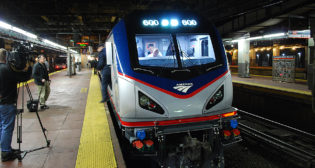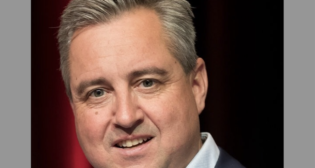
Will Matt Rose succeed Warren Buffett at Berkshire Hathaway?
Written by William C. Vantuono, Editor-in-Chief
As has happened after every Berkshire Hathaway annual shareholders meeting since 2010, when Burlington Northern Santa Fe Corp. became a major part of Warren Buffett’s portfolio, the question is raised as to who will be the successor to the now-82-year-old “Oracle of Omaha.”
 Not surprisingly, the potential successor most often speculated about is BNSF Chairman, President, and CEO Matt Rose. And why not? Rose leads the team at BNSF that made the railroad so attractive to Buffett—who invests for long-term growth—that he acquired 100% of the company. (When that happened, Rose became Railway Age’s hands-down pick for Railroader of the Year.) From my perspective, knowing what I do about BNSF Railway, Buffett would do very well to appoint the relatively young (at 52) Matt Rose as Berkshire’s next chief executive.
Not surprisingly, the potential successor most often speculated about is BNSF Chairman, President, and CEO Matt Rose. And why not? Rose leads the team at BNSF that made the railroad so attractive to Buffett—who invests for long-term growth—that he acquired 100% of the company. (When that happened, Rose became Railway Age’s hands-down pick for Railroader of the Year.) From my perspective, knowing what I do about BNSF Railway, Buffett would do very well to appoint the relatively young (at 52) Matt Rose as Berkshire’s next chief executive.
According to a recent Reuters report, Buffett and Berkshire’s board of directors are in lock-step about who will be the next CEO. Could it be Matt Rose? I don’t know the first thing about odds-making, but I’d say they’re far more than even. Here’s what Reuters reported:
“Warren Buffett and the board of his conglomerate Berkshire Hathaway Inc. are ‘solidly in agreement’ on who should be the company’s next chief executive, Buffett said at Berkshire’s annual shareholder meeting on May 4. But Buffett, as with past practice, did not actually name his successor as CEO. Speculation usually focuses on a small group of top Berkshire executives, among them insurance boss Ajit Jain and railroad leader Matt Rose.
“The 82-year-old Buffett, in response to a shareholder question, said he thinks all the time about what could go wrong at Berkshire after he is gone. ‘The key is preserving a culture and having a successor, a CEO that will have more brains, more energy, more passion for it than even I have. . . . We’re solidly in agreement as to who that individual should be,’ Buffett said.
“Whoever ultimately takes over Berkshire will run a conglomerate that employs more than a quarter-million people in dozens of businesses worldwide, covering everything from ice cream to insurance and retail to railroads. Its breadth means that its performance is often seen as a barometer for the broader economy. Earlier [during the meeting], one of Buffett’s top lieutenants said things were picking up but could improve further. ‘It feels like a 2% economy. If we want to see GDP click up to 3.5%, 4%, you need to see more consumption,’ said Matt Rose. [He] said BNSF was seeing ‘across the board’ increases in demand to ship things like concrete, roofing tiles, and cars.”
Under Matt Rose’s leadership, BNSF has done extremely well for Buffett and Berkshire Hathaway shareholders. Take a look at the railroad’s 2012 financials (figures in millions of dollars):
• Revenues: $20,835.
• Operating expenses: $14,835.
•Operating earnings before interest and taxes: $6,000.
• Interest (net): $623.
• Income taxes: $2,005.
• Net earnings : $3,372.
BNSF’s net 2012 earnings of $3.372 billion were a record, and a 12% improvement over 2011’s $2.972 billion.
In his March 1, 2013 Letter to Shareholders, Buffett had this to say about BNSF:
“A key characteristic . . . is [its] huge investment in very-long-lived, regulated assets, with these partially funded by large amounts of long-term debt that is not guaranteed by Berkshire. Our credit is in fact not needed because [BNSF] has earning power that even under terrible conditions amply covers its interest requirements. In last year’s tepid economy, for example, BNSF’s interest coverage was 9.6x. (Our definition of coverage is pre-tax earnings/interest, not EBITDA/interest, a commonly-used measure we view as deeply flawed.)
“Every day, [BNSF] powers the American economy in major ways. BNSF carries about 15% (measured by ton-miles) of all intercity freight, whether it is transported by truck, rail, water, air, or pipeline. Indeed, we move more ton-miles of goods than anyone else, a fact making BNSF the most important artery in our economy’s circulatory system. BNSF also moves its cargo in an extraordinarily fuel-efficient and environmentally friendly way, carrying a ton of freight about 500 miles on a single gallon of diesel fuel. Trucks taking on the same job guzzle about four times as much fuel.
“Our confidence is justified both by our past experience and by the knowledge that society will forever need massive investments in transportation. . . . It is in the self-interest of governments to treat capital providers in a manner that will ensure the continued flow of funds to essential projects. And it is in our self-interest to conduct our operations in a manner that earns the approval of our regulators and the people they represent. Our managers must think today of what the country will need far down the road. [T]ransportation projects can take many years to come to fruition; a growing country simply can’t afford to get behind the curve.
“We have been doing our part to make sure that doesn’t happen. Whatever you may have heard about our country’s crumbling infrastructure in no way applies to BNSF or railroads generally. America’s rail system has never been in better shape, a consequence of huge investments by the industry. We are not, however, resting on our laurels: BNSF will spend about $4 billion on the railroad in 2013, roughly double its depreciation charge and more than any railroad has spent in a single year.
“In Matt Rose, at BNSF, and Greg Abel, at MidAmerican, we have two outstanding CEOs. They are extraordinary managers who have developed businesses that serve both their customers and owners well. Each has my gratitude and each deserves yours.”
I would say that’s a pretty solid endorsement of Matt Rose.



